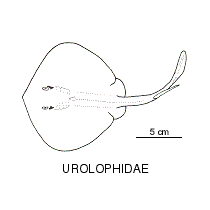- Classification
- CHONDRICHTHYES
- MYLIOBATIFORMES
- UROLOPHIDAE
-
Fish Classification
-
Class
CHONDRICHTHYES Sharks, rays ... -
Order
MYLIOBATIFORMES -
Family
UROLOPHIDAE Stingarees
Family UROLOPHIDAE
Stingarees, although similar to the well-known stingrays of the Family Dasyatidae, have a small caudal fin and a shorter tail. Disc oval to nearly circular from above, width in adults 15 cm to over one metre; head flat or only slightly raised, snout mostly obtuse and extended little; mouth with many small teeth in oblique rows; 5 pairs of gill slits on ventral surface; tail rather short, not whip-like, with 1 or 2 serrated barbs preceded by small dorsal fin in some species; skin folds, if present, restricted to lateral margins of tail; skin in Australian species smooth, naked. Viviparous reproduction.
Stingarees are live bearers and live on the soft bottoms in bays, estuaries, inshore coastal waters and offshore on the continental shelf and upper continental slope. The maximum length is about 1.2 metres.
Species are restricted to the Indo-West Pacific region, and most occur on the continental shelf around Australia.
Similar to the better known Stingrays, family Dasyatididae, but with small caudal fin and a shorter tail. Disc oval to nearly circular from above, width in adults 15 cm to over one metre; head flat or only slightly raised, snout mostly obtuse and extended little; mouth with many small teeth in oblique rows; 5 pairs of gill slits on ventral surface; tail rather short, not whip-like, with 1 or 2 serrated barbs preceded by small dorsal fin in some species; skin folds, if present, restricted to lateral margins of tail; skin in Australian species smooth, naked. Viviparous reproduction.
More Info
|
Family Taxonomy |
The family contains two genera with about 30 described species. In Australia, 21 described species are known in the two genera Urolophus and Trygonoptera. |
|
Family Distribution |
Endemic to temperate waters of the southern half of Australia. Stingarees inhabit sandy, shelly and muddy bottoms in bays, estuaries, and inshore and offshore waters of the continental shelf and upper continental slope. |
|
Family Description |
Disc oval to nearly circular from above, width of adults 15 cm to over one m; head flat or only slightly raised, snout mostly forming broad angle and extended little; mouth with many small teeth in oblique rows; 5 pairs of gill slits on ventral surface; tail rather short, not whip-like, with 1 or 2 serrated barbs preceded by small dorsal fin in some; skin folds, if present, only on lateral margins of tail; skin in Australian species smooth, naked. |
|
Family Size |
To a maximum length of 1.2 metres. |
|
Family Feeding |
Carnivores - feed mostly on bottom-living invertebrates such as crustaceans and polychaete worms. |
|
Family Reproduction |
All rays have internal fertilization and stingarees are vivparous, meaning that females give birth to live young. Urolophids are aplacental viviparous (ovoviviparous), meaning that the embryos hatch from eggs inside the uterus, and following further development within the uterus, they are born live. After the yolk has been absorbed, the embryos are nourished by histotroph, a special 'uterine milk' produced by the mother. |
|
Author |
Dianne J. Bray & Martin F. Gomon |
References
Last, P.R & Gomon, M.F. 1987. New Australian fishes. Part 15. New species of Trygonoptera and Urolophus (Urolophidae). Memoirs of Museum Victoria 48(1): 63-72
Last, P.R. & Compagno, L.V.J. 1999. Family Urolophidae. pp. 1469-1476 in Carpenter, K.E. & Niem, V.H. (eds). The Living Marine Resources of the Western Central Pacific. FAO Species Identification Guide for Fisheries Purposes. Rome : FAO Vol. 3 1397-2068 pp.
Last, P.R. & Stevens, J.D. 1994. Sharks and Rays of Australia. Canberra : CSIRO Australia 513 pp. 84 pls
Last, P.R. & Stevens, J.D. 2009. Sharks and Rays of Australia. Collingwood : CSIRO Publishing Australia 2, 550 pp.
McCulloch, A.R. 1916. Report on some fishes obtained by the F.I.S. Endeavour on the coasts of Queensland, New South Wales, Victoria, Tasmania, South and South-Western Australia. Part 4. Biological Results of the Fishing Experiments carried on by the F.I.S. Endeavour 1909-1914 4(4): 169-199 figs 1-2 pls 49-58 [pl. L]
McKay, R.J. 1966. Studies on Western Australian sharks and rays of the families Scyliorhinidae, Urolophidae and Torpedinidae. Journal of the Royal Society of Western Australia 49(3): 65-82 figs 1-6
Nelson, J.S. 1994. Fishes of the World. New York : John Wiley & Sons 600 pp.
Séret, B. & Last, P. 2003. Description of four new stingarees of the genus Urolophus (Batoidea: Urolophidae) from the Coral Sea, south-west Pacific. Cybium 27(4): 307-320.























































































